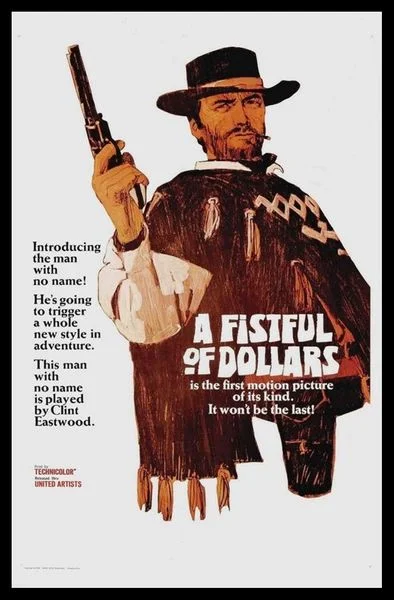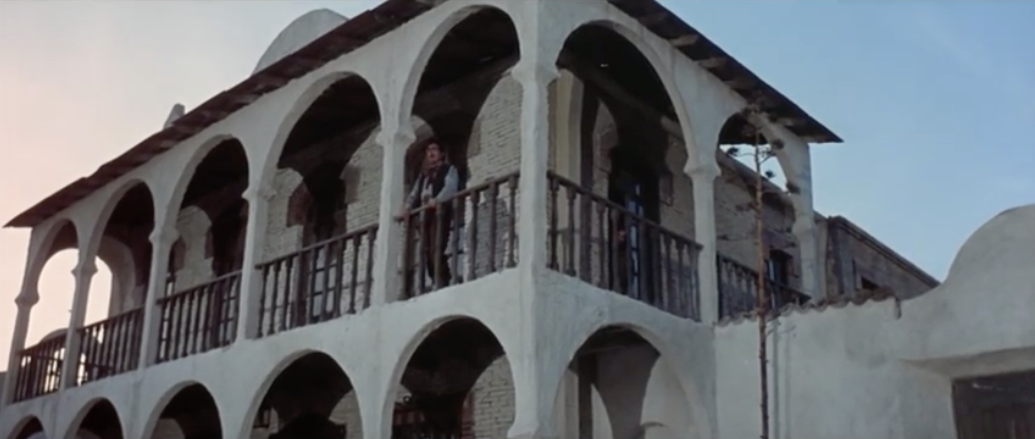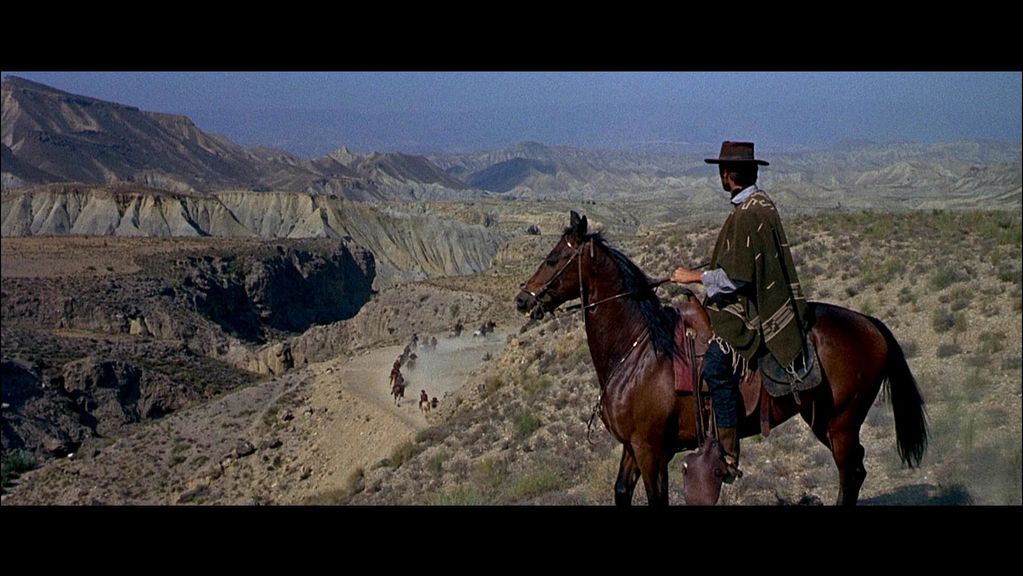Western #6: A Fistful of Dollars
Inevitably, there comes a time when tradition is subverted and a fresh voice throws convention out the window. For the Western genre, this came in the form of Spaghetti Westerns - Italian filmmakers who adopted the Western genre tropes in their own upstart style. A Fistful of Dollars (1964), directed by Sergio Leone and introducing Clint Eastwood in his first starring film role, was the first commercially successful Spaghetti Western and thrust Eastwood into star status. In this tale, there is no gallant hero that sides with right and defeats villainy; rather, a man plays both sides of a corrupt town in order to reap their money. The sixth film in this Western Marathon ushered in a new era of Westerns that moved beyond the Hollywood studio systems stable fare, led by a team of international filmmakers who co-opted the American West to tell their own tales.
The Man With No Name enters a town surrounded by wilderness and infested with corruption. His welcome to the town - “You will get rich here, or you’ll be killed.” The Stranger becomes determined to achieve the former and immediately proves his talent as a sharpshooter, easily killing four men from the sheriff's posse in a gunfight. He then decides to pit the town’s rival families - the scheming Rojos and the corrupt Baxters - against each other, playing each side with half-truths that create a false sense of trust, which then initiates situations that begets violence. While the family gangs focus on fighting, the Stranger searches for stolen gold and also helps an imprisoned family escape the town. Eventually, the gangs realize the game the Stranger has been playing and he is captured and tortured by the Rojos. He escapes and recovers just outside of town. The rival gangs have descended into all out warfare, with the Rojo family setting fire to the Baxter home and killing their entire family, while also capturing and torturing the Strangers only friend in the town. He returns to town, confronting the Rojo’s gang leader in a one on one shootout in the middle of town. In a race to reload empty guns, the Stranger shoots the Rojo’s leader first and finally takes his leave of the devastated town.
Spaghetti Westerns describe an offshoot branch of the Western that was produced in Italy, beginning in the mid-1960s. The new sub-genre featured international cast and crews, widescreen cinematography, and Roman Catholic iconography. The troupes of the Western, covered in this Marathon’s overview, were either exaggerated or inverted; for example, the villains are portrayed as more hyperbolic, while the heroes are transformed from the white hat sheriff in the mold of John Wayne to become black hat loners in the ground-breaking mold of Clint Eastwood. Finally, the films have a focus on ostentatious violence and nonstop action. Most of these traits were defined in the first commercially successful Spaghetti Western, A Fistful of Dollars, and then the number of productions rapidly expanded for the next ten years, finally slowing by the end of the seventies. Now, only homages to the sub-genre, such as Quentin Tarantino’s Django Unchained (2012), are produced, but the effects of breaking open the genre tropes are still felt today with modern Western storytelling and production design.
One of the first indications that the viewer is experiencing a new and different type of Western comes in an early scene, where the Stranger recognizes that he must prove his gun skills to the entire town - so he approaches the men who have taken his horse. The camera is set at Eastwood’s back, with his gun hand framed in the lower left corner and his opponents in the near distance. In an incredible display of quickness and brutality, he draws his weapon and takes down the four men in the sheriff’s posse, without an editing cut nor a hint of remorse from the hero.
It now is made clear to the audience and the town that Eastwood’s portrayal of The Man With No Name is one of an anti-hero, whose mission is to play both sides of the town against each other for the potential individual profit, blurring any sense of the traditional Western’s emphasis on morality and ethics; the viewer, however, still roots for the Stranger to win, as he does some redeeming acts and he is a hell of a lot better than the rest of the gangs in the town. For example, he reunites a family that had been torn apart by the gangs, giving them some money and enabling them to escape the frontier town with the hope for a better life. When questioned why he took this action, he response: “Cuz i knew someone like you once and there was no one there to help.” Was this his mother? Someone important from his past? The script doesn’t deign to answer, only deepening the audience’s interest in this protagonist. In addition, this anti-hero relies on cunning and improvises his way out of situations, as when he hides in a coffin to escape the town in order to recover from his wounds. This type of ingenuity and cleverness in the protagonist was a refreshing element to see in a Western flick.
Another way the film subverts the traditional Western genre tropes is in the final shootout. While a lone man does appear in the center of the town and his final showdown is against the story’s main villain, both familiar elements from the baseline genre, the film takes both to new levels. Eastwood makes a dramatic entrance, as mists from a dynamite explosion clears and reveals his presence in the street. The Stranger has used his smarts to upgrade the battle with armor and uses psychological warfare to taunt the Rojo brother into playing his game. He challenges the man to a deadly race of loading an empty gun to see who can shoot the other first. This shootout isn’t about force of numbers or watching the good guys prevail over the outlaws - this is a one on one battle of skill and daring, one that the Man With No Name easily wins. He puts his life on the line for revenge, confident in his skills, but when the other Rojo brother takes deadly aim, the Stranger’s two friends in the town come to his aid. The film seems to be making a grand message about the lone man, but he is constantly needing help from friendly faces in the town.
Perhaps because the story was written and the film produced outside of the United States, away from the institutionalized racism and sexism that is typically part of the Western genre, the film has different ways of portraying the Mexicans and women in the town. First off and very notably, the Man With No Name does not have a love interest at all; he does not pursue any of the women he comes across, he isn’t in the town looking for love nor a woman’s companionship - he is there for money and nothing else. He encounters a woman who is basically enslaved and helps to free and reunite her with her husband and young son, which is his one admirable act. He also negotiates with the sheriff’s wife, who is also Mexican, when he begins to play the two families against each other. She makes the final decisions in their tete a tete, even though her husband arrives to witness the discussions. In her final moments, after the Rojo gang has destroyed her family, her husband, and her home, she still makes an impassioned speech, defying her killers in her final moments. She is a strong, independent, and feisty woman, exceeding the stock figures usually found in Western fare.
The cast of the film is also quite diverse, and while many Hollywood studio system Westerns did cast Hispanic actors in bit parts, these actors take on more prominent positions in the story, as would be realistic on the actual frontier. The audience is not presented the Rojo family as stock villains; rather, as the Stranger is housed in their compound, their inner life and complex relationships are revealed, showing a more robust portrayal of Mexican culture than is usually displayed on screen. This advance, however, is undercut by other aspects of the film. The Rojo family refers to white people as “Americanos,” an interesting linkage between the fledgling American country and the people who populate it, with the language suggesting that the Hispanic families in the town are separated from the new country. The film also attributes significantly more violence to the Rojo family than the Baxter family; for example, when the Rojo gang steals from the US Government, an incident referred to as the “Massacre at Rio Bravo,” the filmmakers focus on the ruthlessness nature of the attack, positioning the camera behind a machine gun in order to visually capture the spray of bullets that mercilessly mows down the surprised men. This trend continues in the final showdown between the rival families, where the Rojo posse has set the Baxter’s house ablaze, and the gang rushes out of the flames, only to meet their deaths at the hands of the Rojo’s bullets. The camera frames closeups on the Rojo’s faces, displaying the laughter and glee as they shoot down their enemies, and is sustained for a significant period of time, highlighting the cruelty of the men. For a film that is more diverse in its casting and portrayal of women and minorities, it still positions brown men as overly violent towards white people.
Sergio Leone gained renown for not only breaking open standard storytelling in Westerns, but he also was a talented filmmaker. His awareness of physical space and then creative choices in camera placement elevated his films from pulp fare to sophisticated filmmaking. For example, in A Fistful of Dollars, he frequently utilized buildings, fences, and furnitures as framing devices, employing the rules of thirds, and also depth of field for multiple planes of staging and action. This type of framing is much more sophisticated than the shots in a Hollywood studio system Western.
There are so many visual setpieces that deserve highlighting, such as when the Stranger is on the run from the Rojo gang. Their leader is jumping about on a building porch, yelling for his men to disperse and find the fugitive, and, unbeknownst to him, Eastwood’s anti-hero has buried himself under that very porch to hide. Not only is this very clever storytelling, but delightful choreography from the director. Another great sequence is when the Stranger has quietly stolen back into town to rescue his friend from the Rojo’s torture. The camera follows Eastwood as he carefully climbs his way across a barn’s crossbeams, with the audio of his friend’s misery overlaying the images. Leone doesn’t abandon all Western visual tropes in the movie, as he does include scenes of horses on full on gallops racing through the desert landscape.
Not all elements of the production were top quality and some techniques that were common at the time don’t hold up well in retrospection. The opening title animations are presented in stark black and orange flat colors, horses running across the screen, and incredibly cheesy bullet sounds fire when a credit is introduced. This title sequence doesn’t quite set the viewer up for the serious and dramatic tale they are about to witness, so expectations are set far afield from the actual tone of the film. Additionally, the filming technique in Italy at the time was to not capture sound during production, but to to dub the film later with the actor’s voices. This produces a mismatch between the actors lips and the line reading, which distracts from Leone’s brilliant staging and Eastwood’s serious acting. One particular sequence where the Rojos and the Baxters are facing off at a cemetery has just awful night lighting. And finally, despite some excellent makeup on Eastwood to show how terribly he has been beaten by the Rojo gang, the movie’s design team just couldn’t quite realistically capture the essence of blood. It often looks chunky and doesn’t quite flow like the real deal. The film holds up as a classic despite these quibbles over production quality.
In order for a complete analysis of the film, one must consider the fantastic score from composer Ennio Morricone, who went on to be an influential voice in film and television music. The main theme is a rich tapestry of sounds, a coordinated cacophony of voices and instruments that conjures visions of outlaws in the dry desert. Morricone didn’t have the budget for an orchestral score, so he relied on stripped down instruments and sound effects such as whip cracks, shots firing, and voices chanting phrases such as “we can fight!” The main theme features guitar strums taken straight from the Old West that combine with the piercing flute, floating the melody over bell chimes and fluttering chirps that cascade down the scales. Morricone continued to collaborate with Leone for the rest of the Dollars trilogy, with his score for the final film (The Good, the Bad, and the Ugly) considered as the crowning achievement of the series.
Overall, this film was a welcome break from traditional Western films. The inventiveness of the writing, camera placement, and score imparted fresh life into a worn down genre, infusing it with new character archetypes and interesting stories to tell. Clint Eastwood’s film debut was a staggering performance of restraint and ruthlessness, positioning his anti-hero as far from John Wayne’s cowboy hero as possible. These aspects have placed it close to the top in the rankings of this Western Marathon and, with only two more entries to consider, we move next to Anthony Mann’s 1950 collaboration with James Stewart in Winchester ‘73.










